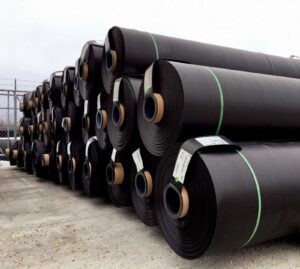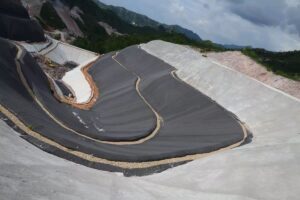What is HDPE geomembrane?
HDPE geomembrane is a geomembrane made of high-density polyethylene (HDPE) material. HDPE is a thermoplastic with high density, high strength, high chemical resistance and good tensile resistance.
The following are some properties and applications of HDPE geomembrane:
High Density Polyethylene (HDPE): HDPE is a thermoplastic polyethylene with a relatively high density. This gives HDPE geomembrane excellent physical and mechanical properties, making it suitable for a variety of civil engineering applications.
Anti-permeability: HDPE geomembrane has good anti-permeability properties due to its high density and can be used for waterproofing, anti-penetration and soil protection.
Chemical resistance: HDPE has good resistance to many chemicals and can be used for a long time in environments affected by chemicals.
Anti-tensile properties: HDPE geomembrane has excellent anti-tensile properties, which enables it to provide effective support and stability in soil reinforcement and protection projects.
Weather resistance: HDPE geomembrane usually has good weather resistance and can maintain stability under various climate conditions.
Environmental protection: Compared with some other materials, HDPE geomembrane usually has better environmental performance and can be recycled and reused.
Widely used: HDPE geomembrane is widely used in water conservancy projects, environmental projects, civil engineering and construction projects for waterproofing, anti-penetration, soil reinforcement, waste treatment and other fields.

What are the characteristics of HDPE geomembrane?
HDPE geomembrane (High-Density Polyethylene Geomembrane) has many characteristics, making it a geotechnical material widely used in civil engineering, environmental engineering and water conservancy projects. The following are the main features of HDPE geomembrane:
Excellent anti-penetration performance: HDPE geomembrane has excellent anti-permeability and can effectively prevent the penetration of moisture, liquid and gas, and is used for waterproofing and anti-penetration projects.
Excellent tensile resistance: HDPE geomembrane has high tensile strength and stiffness, can withstand external stress, and provides soil stability and support.
Good chemical resistance: HDPE geomembrane has good resistance to many chemical substances and can be used in different environments, including resistance to corrosive substances such as acids and alkalis.
Good aging resistance: HDPE geomembrane has good aging resistance and can maintain stable performance in outdoor environments for a long time.
Good weather resistance: HDPE geomembrane has stable performance under different climate conditions and is not easily affected by ultraviolet rays and oxidation.
Easy to weld: HDPE geomembrane can be connected through thermal welding, extrusion welding, etc. to form an overall sealed structure, which improves the convenience and speed of engineering construction.
Lightweight: Compared with geomembranes made of other materials, HDPE geomembranes are relatively light and easy to transport and install.
Environmental protection: HDPE geomembrane is an environmentally friendly material that can be recycled and reused to reduce the impact on the environment.
Good flexibility: HDPE geomembrane has good flexibility and strong adaptability, and can adapt to various terrains and engineering needs.
Multipurpose: HDPE geomembrane is suitable for various engineering fields, including water conservancy projects, environmental protection projects, waste treatment, transportation infrastructure, etc.
These characteristics make HDPE geomembrane widely used in various engineering projects to solve problems such as waterproofing, anti-seepage, soil reinforcement, and waste disposal. HDPE geomembrane is a geomembrane made of high-density polyethylene (HDPE) material. HDPE is a thermoplastic with high density, high strength, high chemical resistance and good tensile resistance.
The following are some properties and applications of HDPE geomembrane:
High Density Polyethylene (HDPE): HDPE is a thermoplastic polyethylene with a relatively high density. This gives HDPE geomembrane excellent physical and mechanical properties, making it suitable for a variety of civil engineering applications.
Anti-permeability: HDPE geomembrane has good anti-permeability properties due to its high density and can be used for waterproofing, anti-penetration and soil protection.
Chemical resistance: HDPE has good resistance to many chemicals and can be used for a long time in environments affected by chemicals.
Anti-tensile properties: HDPE geomembrane has excellent anti-tensile properties, which enables it to provide effective support and stability in soil reinforcement and protection projects.
Weather resistance: HDPE geomembrane usually has good weather resistance and can maintain stability under various climate conditions.
Environmental protection: Compared with some other materials, HDPE geomembrane usually has better environmental performance and can be recycled and reused.
Widely used: HDPE geomembrane is widely used in water conservancy projects, environmental projects, civil engineering and construction projects for waterproofing, anti-penetration, soil reinforcement, waste treatment and other fields.

HDPE geomembrane installation steps
The installation of HDPE geomembrane usually requires experienced professionals to ensure the effectiveness of the anti-seepage system. The following are the general installation steps for HDPE geomembrane, but please note that the specific steps may vary depending on engineering requirements, topography, climate and other factors. Before installing HDPE geomembrane, please be sure to refer to relevant standards and specifications to ensure that the operation meets the corresponding requirements.
HDPE geomembrane installation steps:
1. Preparation:
Check the construction site to make sure the ground is flat and free of sharp objects and sharp stones.
Prepare the required HDPE geomembrane rolls, welding equipment (hot air gun, welding machine, etc.), and welding auxiliary materials (welding rods, welding wires, etc.).
2. Lay the subbase:
Lay a flat base layer, usually using fine sand or gravel to ensure smoothness and stability.
3. Lay HDPE geomembrane:
Lay the HDPE geomembrane on the subbase according to the design requirements. During the laying process, avoid the formation of wrinkles and bubbles to ensure the smooth laying of the geomembrane.
4. Welded seams:
Weld the HDPE geomembrane to ensure the joints are firm and leak-free. A heat gun is usually used to heat the seam and then press the seam so that it melts and bonds together to form a sealed seam.
5. Welding edges:
Weld and fix the edges of the HDPE geomembrane to ensure that the edges are firm and avoid loosening and blistering.
6. Check and fix:
Check the laid HDPE geomembrane to ensure there is no leakage at the joints, bubbles and wrinkles. If problems are found, fix them promptly.
7. Cover with protective layer:
If necessary, cover the surface of the HDPE geomembrane with a protective layer, usually covered with soil or other suitable materials, to protect the geomembrane from external damage.
8. Testing and acceptance:
Conduct permeability tests to ensure that the anti-seepage effect of the geomembrane meets the design requirements.
Conduct acceptance inspection to ensure that the geomembrane installation meets the requirements of relevant standards and specifications.
Author
-

Founded in 2002, Tinhy's team focuses on the manufacturing, marketing, installation, application and research and development of geosynthetic materials.
View all posts




